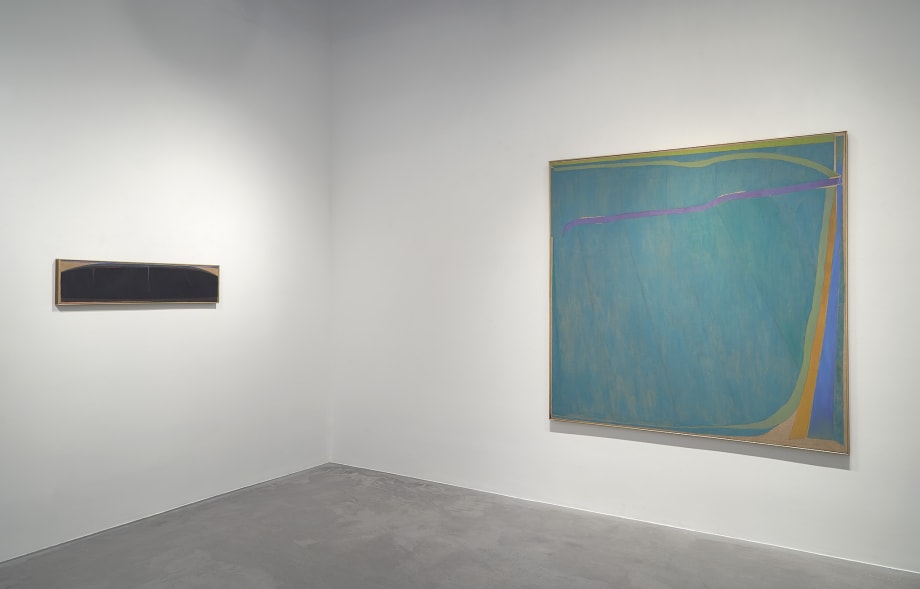Berry Campbell Gallery is pleased to announce the special exhibition Stanley Boxer: The Ribbon Paintings (1971-1976) from November 18 through December 23, 2021. Berry Campbell will present a curated selection of paintings from 1971 to 1976. From 1971 to 1972, the ribbons in these paintings are often suspended, flowing with lyrical elegance. By 1973, Boxer began to layer paint thickly, so that the ribbons began to vibrate and fray under their heavy impasto. These Ribbons Paintings are distinguished by their dichotomous feelings of lyricism and brutality, sensations that would merge by the end of the 1970s and characterize much of his subsequent career. Stanley Boxer: The Ribbon Paintings (1971-1976) will open with a reception on Thursday, November 18, 2021 from 6 to 8 pm. The exhibition continues through December 23, 2021.
For Stanley Boxer (1926–2000), art making was a way of life. Throughout his career, he wrestled with the natural propensities of media and materials and the physical and historical limitations imposed by artistic forms. He was equally inventive in painting, sculpture, and drawing, striving in each for directness of expression. Boxer’s oeuvre has elements of Abstract Expressionist gut emotion and Post-Painterly detachment without belonging to either camp. Boxer’s friend, the art writer Carl Belz associated his approach with that of the writer Gustave Flaubert who felt that “an author in his book must be like God in the universe, present everywhere and visible nowhere.” “Amazed and overwhelmed” by Boxer’s art, Belz commented in a memorial article that creating art for Boxer constituted nothing less “than the making of a world, a construct as vast and complex, as challenging and rewarding, as orderly and chaotic, as public and private, as lived experience.”
The present exhibition at Berry Campbell presents the Ribbon paintings created by Boxer in the first half of the 1970s. These works exemplify his feeling that the open-ended freedom unleashed by creativity was a burden for the “modern” artist, which artists were required to accept while preventing its misuse by being self-challenging, constraining open-endedness. In 1969 and 1970, he created works in which he interwove broad, flat strips of primed cloth glued to his canvases with blocks of color stained into the canvas itself. In 1971, a change occurred in Boxer’s art as he replaced collages that looked like paintings with pure paintings with collage-like aspects. He continued a landscape sensibility but with a new introspective feeling derived from two months in late 1970 when, due to illness, he was confined to Veteran’s Hospital in New York, and his universe narrowed. His only view of the world was that from his window facing the East River. As a result, his works assumed a new topographic and lyrical aspect. In them, the earlier doodles morphed into ribbon-like arcs and bands that he integrated into designs with little tonal variation, while they provided contrasting hues.
In works of 1972, Boxer began integrating the canvas prime into his images, but using exposed areas as color rather than background, maintaining figure/ground unity. At the same time, the ribbons became at times more frayed and calligraphic, as in Rainnights, 1973, in which the bristling elements seem to emanate from within the canvas, and Sunbraid, 1973, in which the ribbon’s shape is more volatile and less secure in its directional movement. Boxer’s surfaces turned more tactile, gestural, and layered in 1974, as he relinquished flat, single colors for fields of shifting, volatile color. One critic related the spectralizing nature of his surfaces to the work of Bonnard. Karen Wilkin observed in 1982 how “the flame-like tones of thickly stroked color” in these works “seemed at once spontaneous and willed. Each ‘ribbon’ seemed to have made its own shape , as though a particular color had meandered across the canvas, but at the same time, we were made acutely aware that this trail of color was the result of a series of repeated, considered gestures which served to spread pigment across the canvas.”
In 1975, the ribbons erupted and began to merge with the surface tactility around them. Wilkin described Boxer’s works as “at once lyrical and brutal, aggressively physical and ineffably elusive.... They depend equally upon laboriously stroked thick oil paint and upon disembodied blushes of color whose substance vanishes as you look.” This description is apt for Roseflakedairabout, 1975, in which the lightly inflected tints are intruded upon by aggressive harsher-toned underlayers that push through the surface.
By 1976, the ribbons became fully suffused into allover designs. As Wilkin observed: “It’s as though the continuous expanse of thick pigment which surrounded the tongues of color in the ribbon pictures had swallowed them and been tinged by them.” Boxer’s Ribbon paintings are the story of an artist engaged in a living and passionate mediation between existential limitlessness and human discipline. His process between 1971 and 1976 allowed him eventually to loosen the latter, freeing the brutality, but without giving in to it. Throughout the rest of his career, he would continue to face inner and outer directional forces with great integrity.

